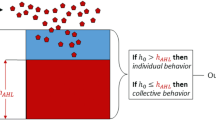Abstract
Bacterial populations meet the challenges of dynamic spatially heterogeneous environments with fluctuating biotic and abiotic factors in a number of ways. The motivation for the work presented here has been to transfer ideas from bacterial adaptability and evolvability to computational problem solving. Following a brief comment on some examples of the ways bacteria solve problems, a bacterially-inspired computational architecture for simulating aspects of problem solving is described. We then examine three case studies. The first, a study of the mutational impact of a remediation to toxic (fitness-reducing) material, highlights how a sufficiently pre-engineered adaptive system can solve a difficult problem quite easily. The second study looks at why it is difficult to evolve complex problem solving behaviours and how artificial selection mechanisms coupled with pre-engineering the system can help. Specifically, this refers to quorum sensing and tactic behaviours. A further study looked at ways in which a quorum sensing analogue could help computational agents find multiple peaks in a landscape. The paper concludes with a discussion of an investigation of bacteria that had both quorum sensing and tactic capabilities.
Similar content being viewed by others
Explore related subjects
Discover the latest articles, news and stories from top researchers in related subjects.References
G Alexandre S Greer-Phillips IB Zhulin (2004) ArticleTitleEcological role of energy taxis in microorganisms FEMS Microbiological Reviews 28 113–126
S Belkin (2003) ArticleTitleMicrobial whole-cell sensing systems of environmental pollutants. Current Opinion in Microbiology 6 206–212 Occurrence Handle10.1016/S1369-5274(03)00059-6
A Bonarini (2000) An introduction to learning fuzzy classifier systems W Lanzi PL Stolzman SW Wilson (Eds) Lecture Notes in Computer Science 1813. Springer-Verlag Berlin 83–106
UT Bornscheuer M Pohl (2001) ArticleTitleImproved biocatalysts by directed evolution and rational protein design Current Opinion in Chemical Biology 5 137–143 Occurrence Handle10.1016/S1367-5931(00)00182-4
AT Bull AC Ward M Goodfellow (2000) ArticleTitleSearch and discovery strategies for biotechnology: the paradigm shift Microbiology and Molecular Biology Reviews 64 573–606 Occurrence Handle10.1128/MMBR.64.3.573-606.2000
Z Chen D Govender R Gross R. Birge (1995) ArticleTitleAdvances in protein-based three-dimensional optical memories BioSystems 35 145–151 Occurrence Handle10.1016/0303-2647(94)01503-Y
TP Curtis WT Sloan JW Scannell (2002) ArticleTitleEstimating prokaryotic diversity and its limits Proceedings of the National Academy of Sciences of the USA 99 10494–10499 Occurrence Handle10.1073/pnas.142680199
Devine P and Paton RC (1997) Biologically-Inspired Computational Ecologies: A Case Study. Lecture Notes in Computer Science 1305 Corne D and Shapiro JL (eds) Springer-Verlag 11–30
MA Dollard P Billard (2003) ArticleTitleWhole-cell bacterial sensors for the monitoring of phosphate bioavailability Journal of Microbiological Methods 55 221–229 Occurrence Handle10.1016/S0167-7012(03)00164-7
R Gregory JR Saunders QH Wu (2004) ArticleTitleParallelising a model of bacterial interaction and evolution Bio Systems 76 121–131
JH Holland (1992) Adaptation in Natural and Artificial Systems: An Introductory Analysis with Applications to Biology Control and Artificial Intelligence Bradford/MIT Press MA
PT Hraber T Jones S Forrest (1997) ArticleTitleThe Ecology of Echo Artificial Life 3 165–190
Y Kuang I Biran DR Walt (2004) ArticleTitleLiving bacterial cell array for genotoxin monitoring Analytical Chemistry 76 2902–2909
MO Magnasco DS Thaler (1996) ArticleTitleChanging the pace of evolution Physics Letters A 221 287–292 Occurrence Handle10.1016/0375-9601(96)00599-3 Occurrence Handle97d:92006
EH Mamdani S Assilian (1975) ArticleTitleAn experiment in linguistic synthesis with a fuzzy logic controller International Journal of Man-Machine Studies 7 1–13
O Matoba B Javidi (2004) ArticleTitleSecure holographic memory by double-random polarization encryption Applied Optics 43 2915–2919
MB Miller BL Bassler (2001) ArticleTitleQuorum sensing in bacteria Annual Review of Microbiology 55 165–199 Occurrence Handle10.1146/annurev.micro.55.1.165
RC Paton (1997) ArticleTitleThe organisations of hereditary information BioSystems. 40 245–255 Occurrence Handle10.1016/S0303-2647(96)01652-8
RC Paton HS Nwana MJR Shave TJM Bench-Capon S Hughes (1991) Transfer of natural metaphors to parallel problem solving applications H-P Schwefel R Maenner (Eds) Parallel Problem Solving from Nature Lecture Notes in Computer Science. Springer-Verlag Berlin 363–372
RC Paton R Gregory C Vlachos JR Saunders QH Wu (2004) ArticleTitleEvolvable Social Agents for Bacterial Systems Modelling IEEE Transactions on Nanobioscience 3 208–216 Occurrence Handle10.1109/TNB.2004.833701
JA Shapiro (1997) ArticleTitleGenome organization, natural genetic engineering and adaptive mutation Trends in Genetics 13 98–104 Occurrence Handle10.1016/S0168-9525(97)01058-5
K Smalla PA Sobecky (2002) ArticleTitleThe prevalence and diversity of mobile genetic elements in bacterial communities of different environmental habitats: insights gained from different methodological approaches FEMS Microbiology Ecology 42 165–175
PS Stewart JW Costerton (2001) ArticleTitleAntibiotic resistance of bacteria in biofilms Lancet 358 135–138
PK Stoodley K Sauer DG Davies JW Costerton (2002) ArticleTitleBiofilms and complex differentiated communities Annual Review of Microbiology 56 187–209 Occurrence Handle10.1146/annurev.micro.56.012302.160705
DS Thaler (1994) ArticleTitleThe evolution of genetic intelligence Science 264 224–225
C Vlachos R Gregory RC Paton JR Saunders QH Wu (2003) ArticleTitleIndividual-based modelling of bacterial ecologies and evolution. Comparative and Functional Genomics 5 100–104
Author information
Authors and Affiliations
Corresponding author
Rights and permissions
About this article
Cite this article
Paton, R.C., Vlachos, C., Wu, Q.H. et al. Simulated Bacterially-Inspired Problem Solving – The Behavioural Domain. Nat Comput 5, 43–65 (2006). https://doi.org/10.1007/s11047-005-5498-x
Issue Date:
DOI: https://doi.org/10.1007/s11047-005-5498-x




